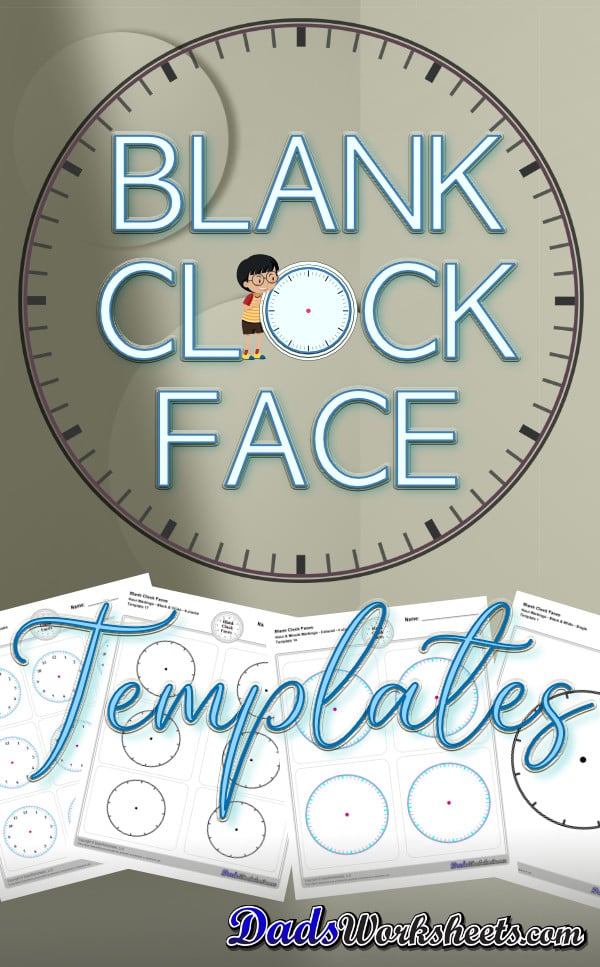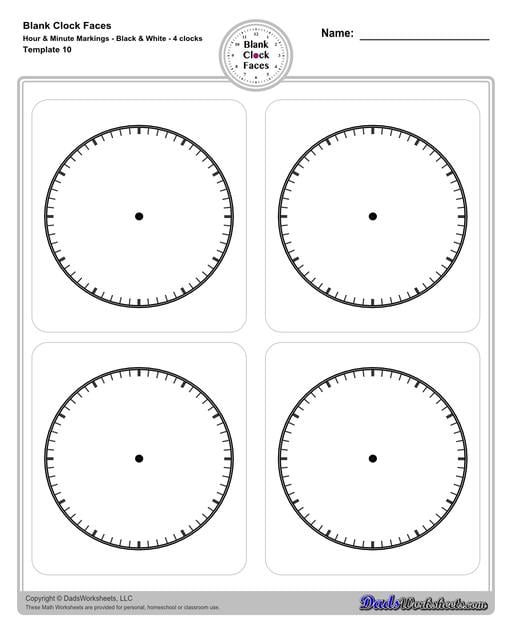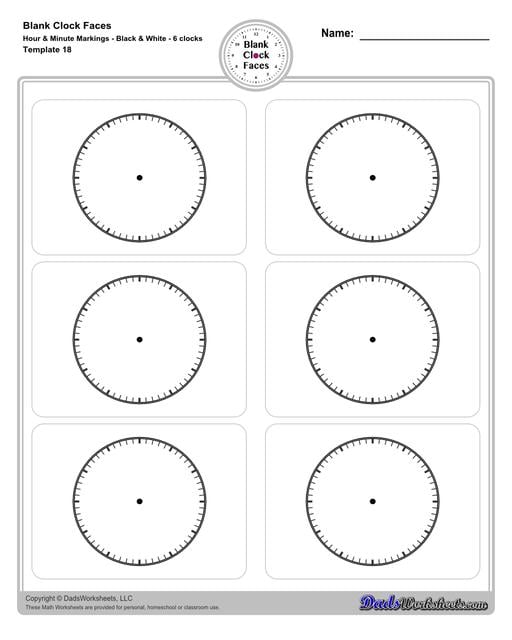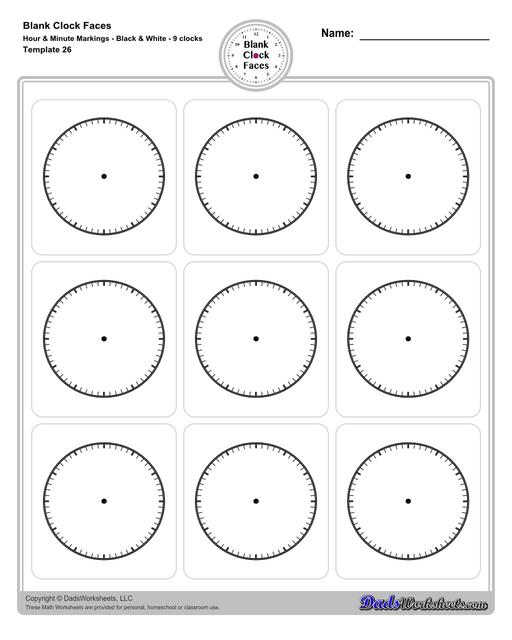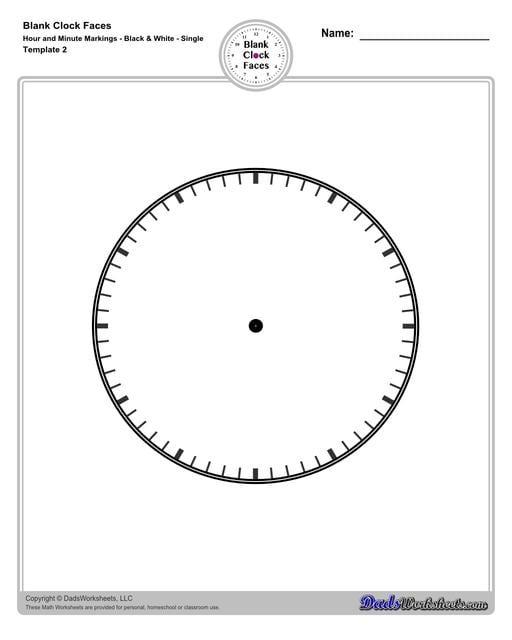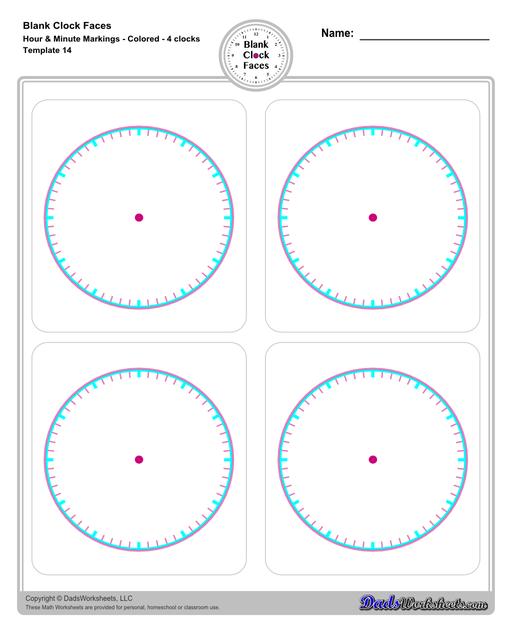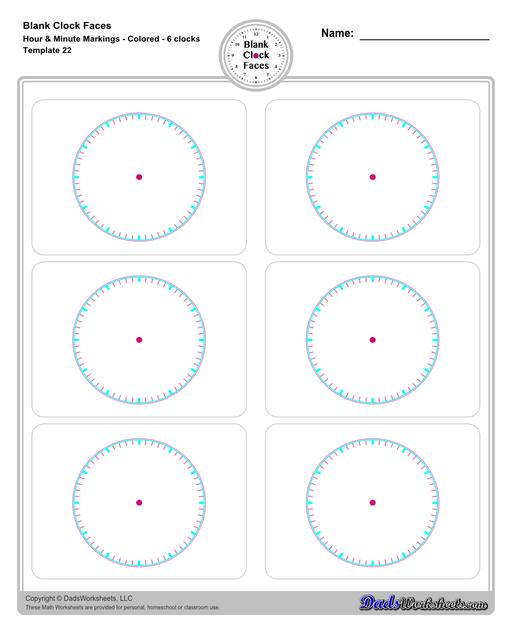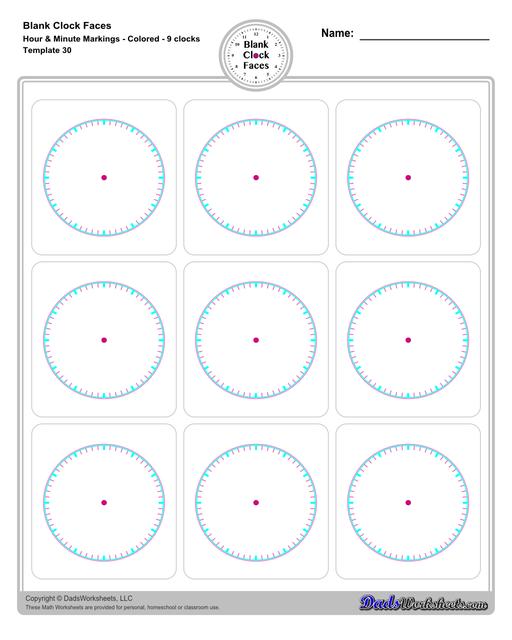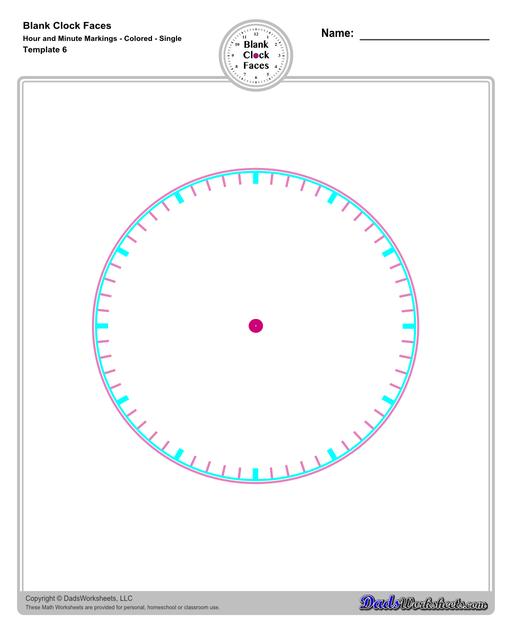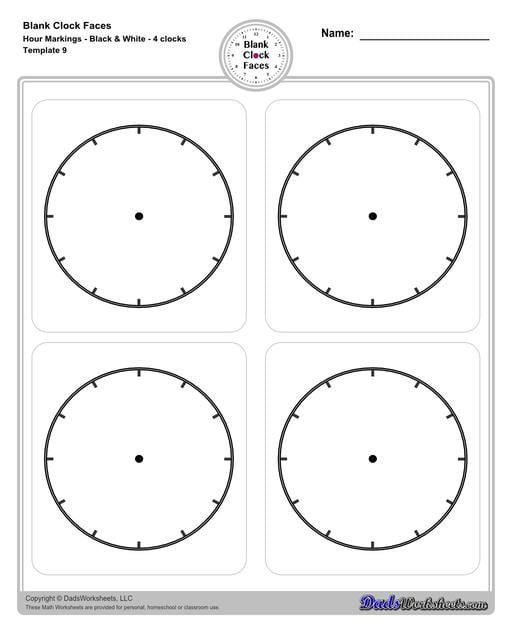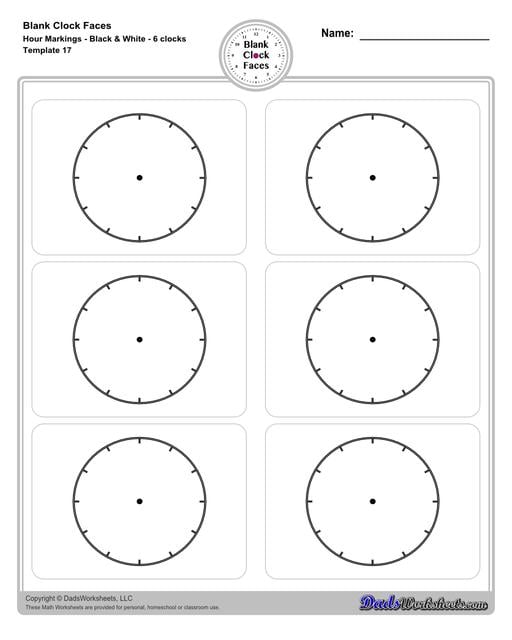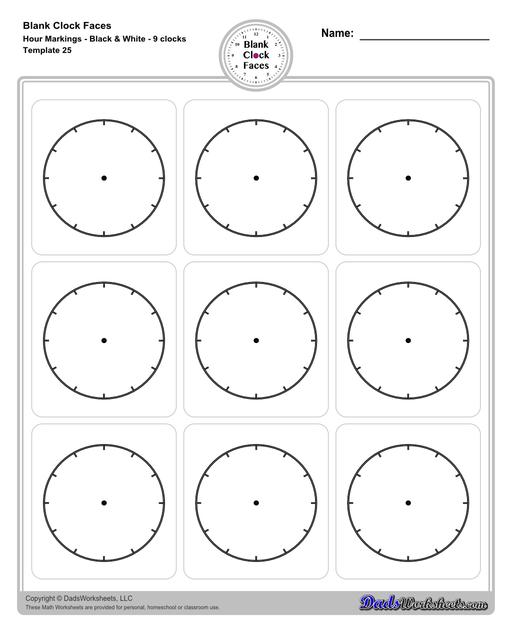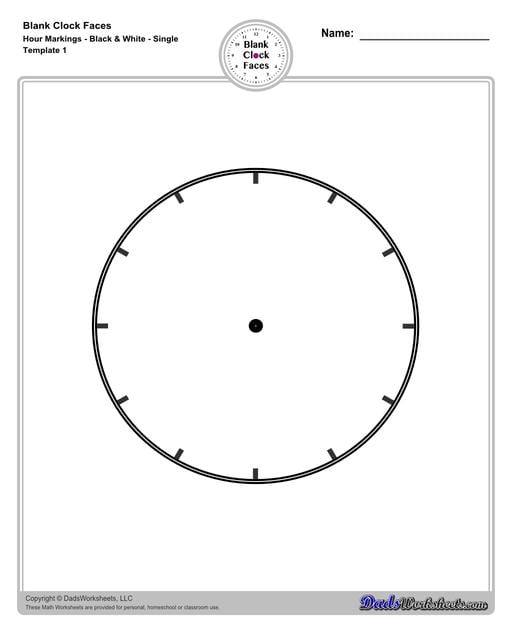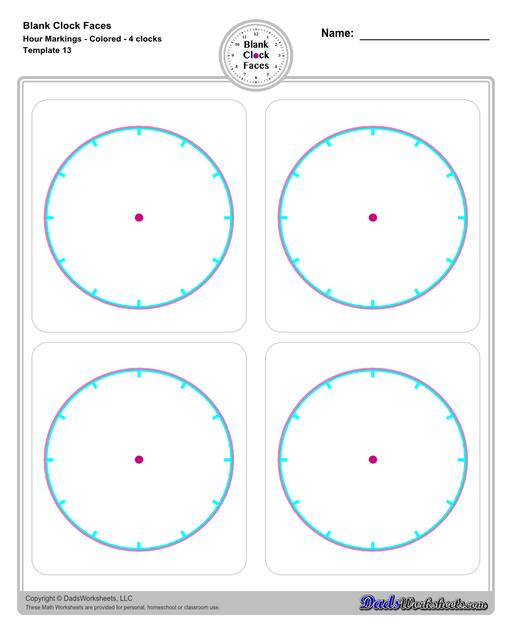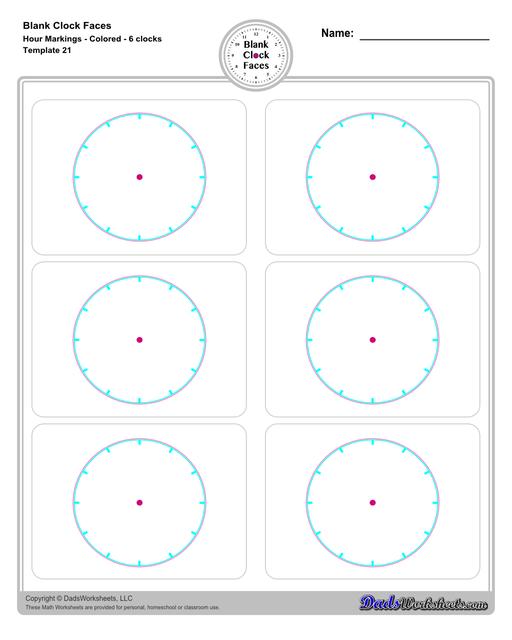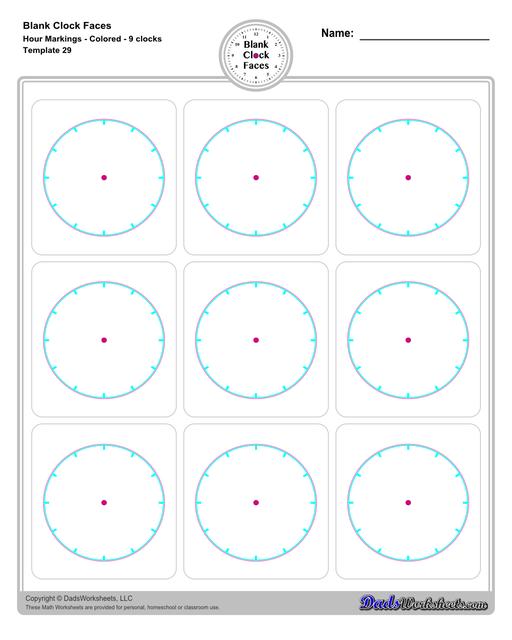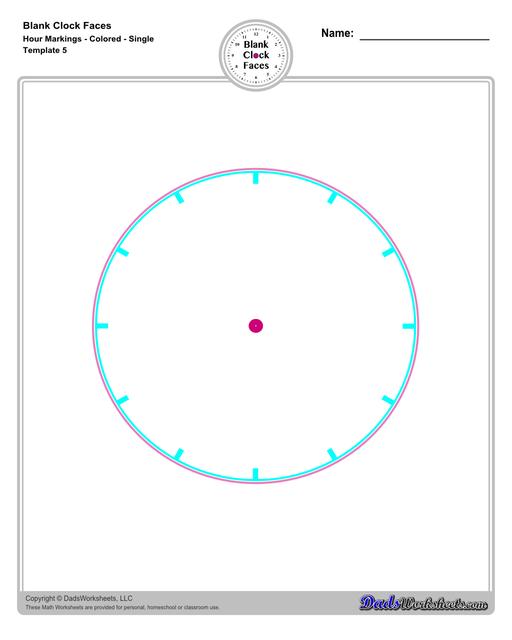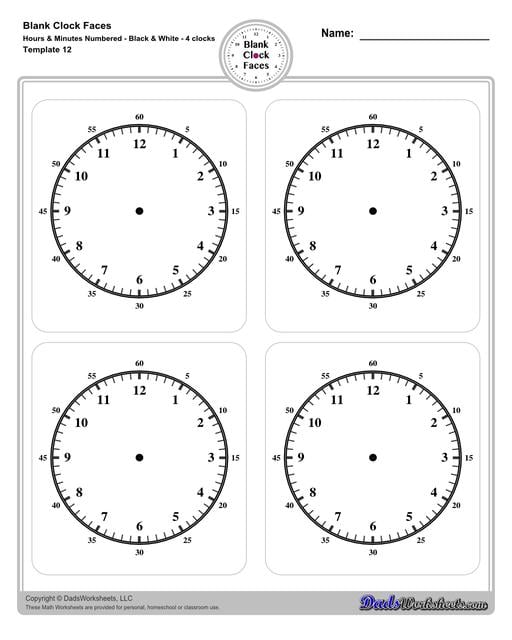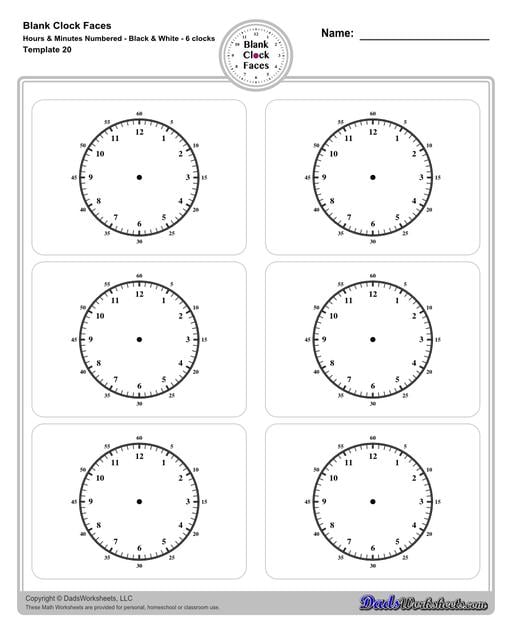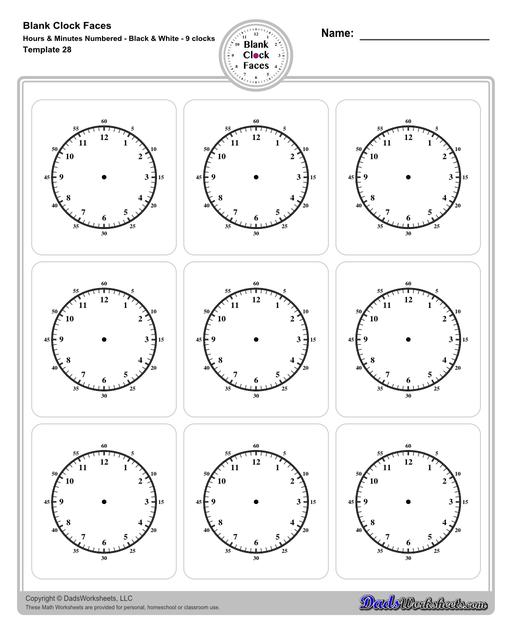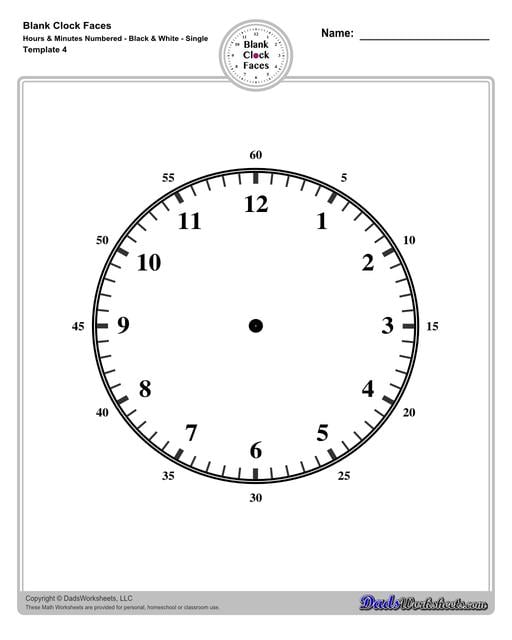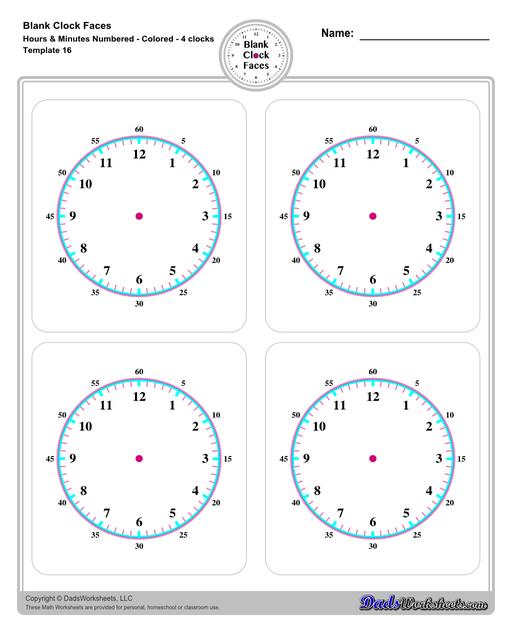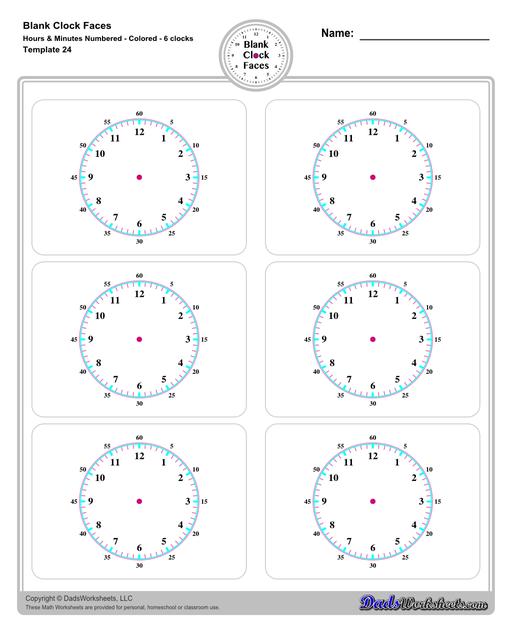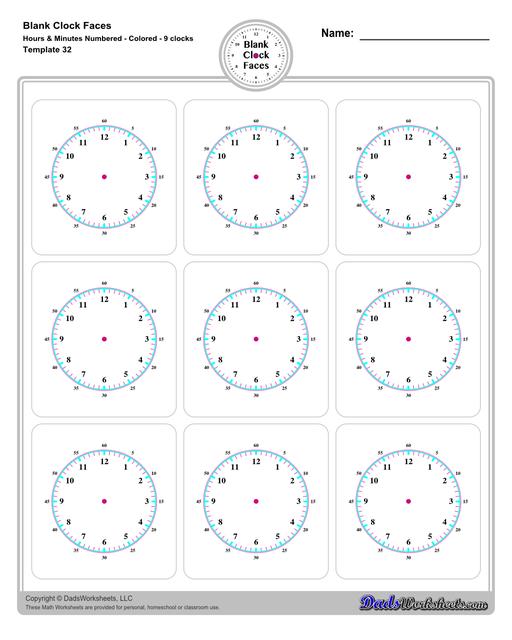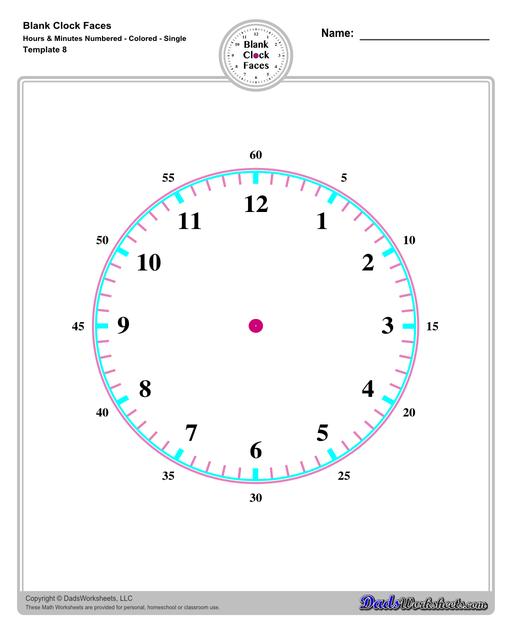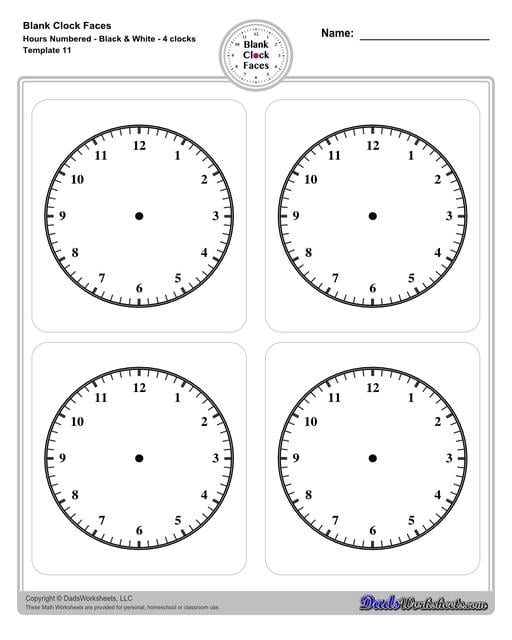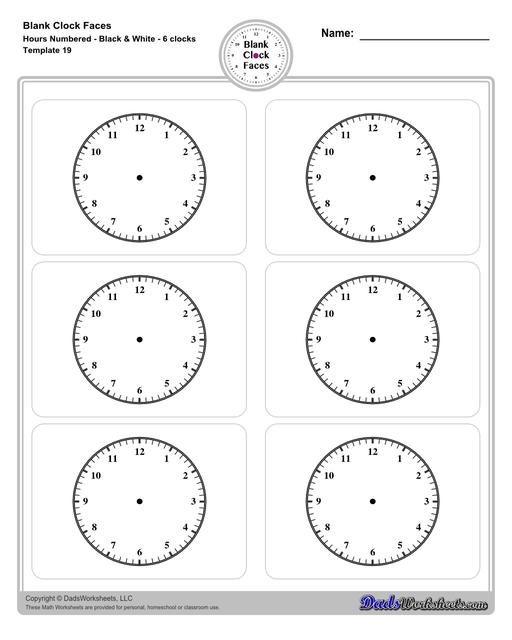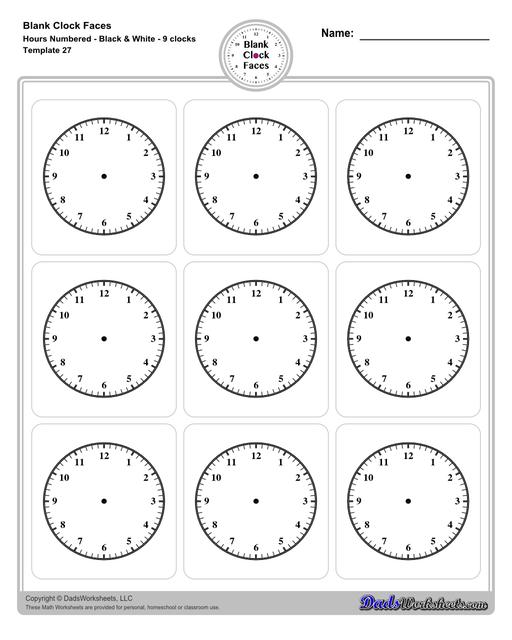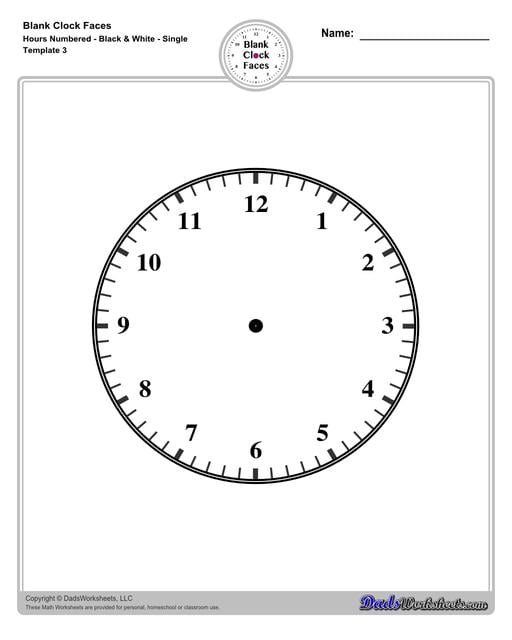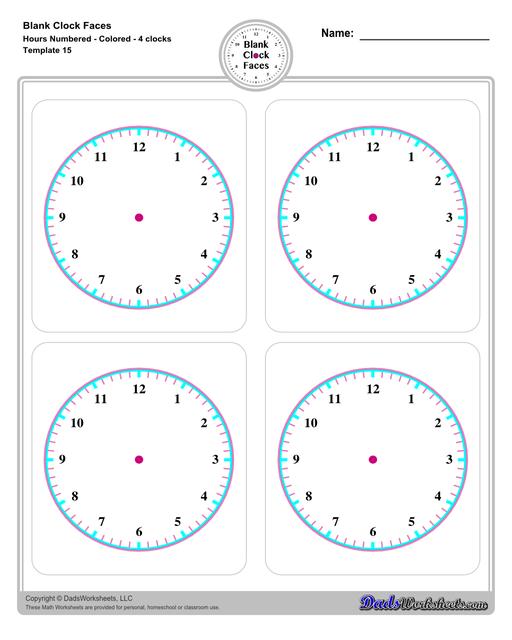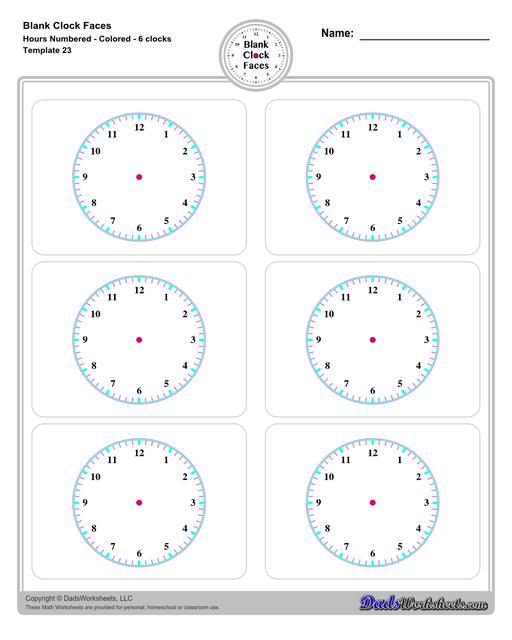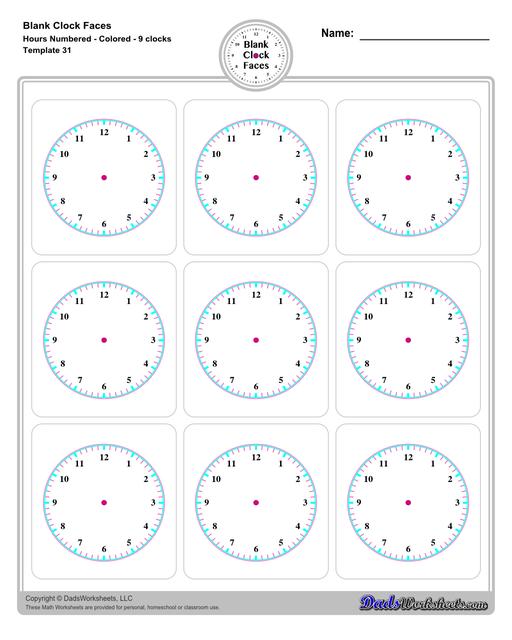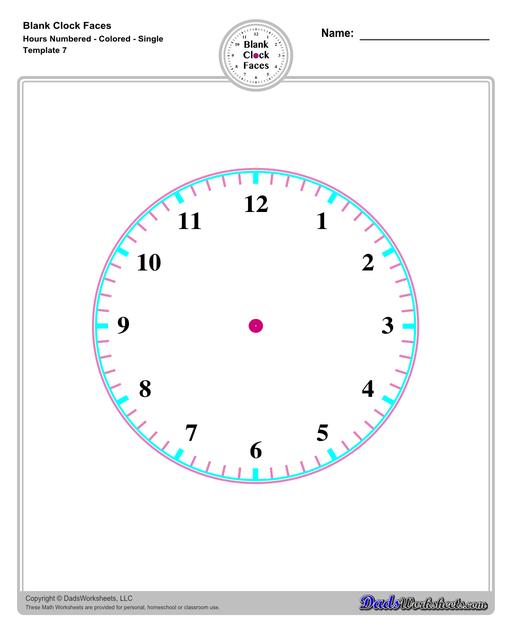Core Math Worksheets
Fraction Worksheets
Algebra
Other Worksheets
Place Value
Percentages
Rounding Numbers
Ordering Numbers
Standard, Expanded, Word Form
Mean Median Mode Range
Ratio Worksheets
Probability Worksheets
Roman Numerals
Factorization, GCD, LCM
Prime and Composite Numbers
Pre-Algebra
Geometry Worksheets
Blank Clocks
Telling Analog Time
Analog Elapsed Time
Greater Than and Less Than
Money
Arithmetic Sequences
Geometric Sequences
Venn Diagram
Graph Worksheets
Measurement & Conversions
Patterns and Puzzles
Color by Number
Holiday & Seasonal
Early Learning
Printables
Calculators
Math Worksheets by Grade
Worksheet News
Printable Blank Clock Face Templates
This page contains 32 printable blank clock face templates that you can use to teach kids how to tell time. Choose from single, 4 clocks, 6 clocks, or 9 clocks to be printed. There are four versions per set ~ with hour markings, hour and minute markings, hours numbered, and hours and minutes numbered. All templates have versions of black and white or colored. If you're running low on colored ink, you can print out the black and white version. If you want your worksheets to be more attractive to your little learners and you have a colored ink on hand, there’s a colored version available as well.
Blank Clock Face with Hour and Minute Markings
Color Blank Clock Face Templates
Blank Clock Face Templates (Hour Markings Only)
Color Blank Clock Face Templates (Hour Markings Only)
Labelled Blank Clock Face Templates
Labelled Blank Clock Face Templates (Color)
Labelled Hours Blank Clock Face Templates
Labelled Hours Blank Clock Face Templates (Color)
How to Use Blank Clock Faces
Use the template with single clocks for starters. Laminate the clocks and use a dry-erase marker to draw different times. You may start with the single clock with hour markings only then draw the numbers one by one from 1-12 to show your kids or students where each number is positioned on the clock. Let them do their own clocks too. This will help them familairize themselves with the placements of the numbers and eventually memorize it by heart. After they are familar with the numbers, the next thing to show them is the hours hand and the minutes hand. I will walk you through the details on how to tell time below. Read on…
How to Tell Time
Teaching how to tell time is appropriate for students in 1st and 2nd grade, or kids 6-7 yrs of age. This may take a couple of months or years to fully master. First, teach your child how to tell time by the hour, then to the half-hour, then to the five-minute interval, and finally to the minute. Meanwhile, these are the step-by-step guide on how you can easily teach time-telling:
Step 1: Identify the parts of the clock
The first step in learning to tell time is being able to identify the parts of a clock. This includes the numbers, the hour hand, the minute hand, and even the second hand. If possible, avoid using a clock with a “second hand” while teaching how to tell time. Meanwhile, these are the parts of the clock:
- The hour numbers 1-12
- The shortest hand is called the hour hand. This shows us the hour we are currently in, depending on the number it is pointing at.
- Another hand which is longer than the hour hand is the minute hand. This indicates each minute that passes within the hour.
- The hand that is usually the slimmest or thinnest is called the second hand. If you watch the clock, it is the hand that moves the fastest.
Step 2: Teach telling time by the hour
Now that we have identified all the parts of the clock, we are now ready with telling time by the hour. Let’s start by showing the kids what time to the hour looks like. Print a blank clock face template and show different examples.

Teach them to first identify the hour using the hour hand (the shortest hand), and then look to see if the minute hand is pointing at number 12. If the minute hand (the longer hand) is pointing at number 12, you read that as “o’clock”. So if the shorter hand is pointing at 3 and the longer hand is pointing at 12, the time is 3 o’clock.
After showing them different examples, print out a blank clock face template with 4,6, or 9 clock faces then let them practice by asking them to write different examples of their own this time. Have them read what they have drawn on their clocks.
You can also dictate the time and ask them to write it on their printed templates. For example, “Can you show what 1 o’clock looks like?” Check to see if they have fully picked up how to tell time by the hour. If yes, move on to the next step.
Step 3: Teach telling time by the half-hour
When you begin this step, it is very important to point out that the hour hand is not always pointing directly at the hour number. When it's pointed between two numbers, the hour of the day is always the lower number. So if the hour hand is pointed between 7 and 8 on the clock, it's 7-something, because 7 is the lower number. It’s best to show them different examples of what it looks like just like what we did on the previous step.

Let them identify where the hour hand is pointing, and then look to see if the minute hand is pointing at number 6. If the minute hand is pointing at number 6, you read that as “thirty”, which means 30 minutes have passed within the current hour indicated in the clock. So if the shorter hand is pointing in between 7 and 8 (7 is the lower number) and the longer hand is pointing at 6, the time is 7:30.
Kids may stay in this phase of being able to identify time to the half-hour for some time. Let them practice until they get the hang of things before proceeding to the next step.
Step 4: Teach telling time by five-minute intervals
The trickiest aspect of teaching how to tell time is letting children understand how number 1 also means 5 minutes, 2 means 10 minutes, 3 means 15 minutes and so on. For this one, you may print the version with hours and minutes numbered. Use this template until the kids are ready to tell time without the minutes numbered on the clock.

Another trick is to tell kids to use multiples of five. For example, if the minute hand is pointing directly at number 1, you multiply 1 by 5, or if the minute hand is directly pointing at number 2, you multiply 2 by 5. Please refer to the images below…

Once kids have mastered this trick, you can start asking them to tell time to the five-minute interval. Print out a blank clock face template with 4,6, or 9 clock faces then let them practice by asking them to write different examples of their own. Ask them to work on only times up to thirty minutes past the hour, such as 7:05, 7:15, or 7:25, but not 7:45 or 7:50. It's best to avoid times past the thirty-minute point until a child is cognitively ready. This can be a complicated concept for kids and is one that often requires a lot of practice.
Step 5: Teach telling time by the minutes
Minute time uses multiples of five, along with little ticks in between big numbers. When the minutes hand is pointed in between a big number on the clock, find the nearest big number that it has passed, multiply that number by 5 (like what we did on step 4), and add that product to how many little ticks are in between. There are four small ticks in between each number. Refer to our example below.

The minute hand is pointed in between the numbers 3 and the 4. The rule of thumb in time telling when a hand is pointed between two numbers is to always use the lower number. In our example, 3 is the lower number. Multiply 3 by 5, the product is 15. Then, count out the number of ticks it takes to get from 15 to where the minute hand is pointed exactly. There are two, so we add 2 to 15. We get 17. The time is 7:17.
Things to Remember About Clocks
- There are twelve numbers on a clock, and each of those numbers represents an hour.
- The 12-hour clock system has the numbers 1 to 12. This clock also represents all 24 hours of the day. The hands on the clock go all the way around the clock twice a day.
- The short hand counts the hours; the long hand counts the minutes, and the thinnest hand counts the seconds.
- The direction that the hands rotate in is always clockwise.
- When the hours hand is pointed exactly at a big number on the clock, the minutes hand will always be pointed directly at 12. This is because the hour changed, so the minutes hand is starting over again.
- When a hand is pointed between two numbers, the lower number is the current hour or minute the time is in.
- Each number on the clock has five minutes on it.
Importance of Clocks and Clock Faces
The clock is a device used to measure and indicate time. It is an essential part of our everyday lives. As a matter of fact, we literally base our daily schedules and routines by them. We often check the time to see if it is already time for meals, time to go to bed, time to rise, to see if we are still early or late for school or work and so on. Let's say you you wanted to get to school by 7:00 but you hav to eat breakfast before that, had to be at a friend's birthday party by 3:30, or wanted to go to bed at 8:00 so that you could get a good night's sleep before tomorrow's field trip. The only way you could do those things is by knowing how to tell time.
Clock is a very important device in planning and controlling how much time to spend on specific activities. Clocks also gave everyone throughout the country a uniform time no matter their location, allowing for the coordination of workforces and increased profit and productivity.
Without clocks in our lives, we could get lost tracking when the next bus or train is set to arrive, when will your favorite show air on television, or if it’s already time to check what you are baking in your oven. Can you imagine living without clocks? It would be not as productive and organized as how we live today. So next time you check the time, be thankful and appreciate the efforts of our ancient ancestors who invented it.
Interesting Fun Facts About Clocks
- AM and PM come from latin words “Ante Meridiem” and “Post Meridiem”. Ante Meridiem means before noon or midday, while Post Meridiem means after noon or after midday.
- "Clock" comes from the Latin word "clocca," which means “bell.”
- The phrase "o'clock" is an abbreviation of "of the clock."
- The world's most expensive clock sold for $6.8 million in 2012.
- The world's oldest working clock is housed in Salisbury Cathedral, England. Historians believe it was built in 1386!
- The world’s highest clock is 229 meters (751 ft 3 in) above street level on top of the Federation Tower “West”, Moscow, Russia. The clock was activated on 24 April 2008.
- The first American alarm clock was invented in Concord, New Hampshire in 1787 by Levi Hutchins. It was never patented and rang only at one time — 4:00 am — to wake him for work.
- The largest collection of clocks belongs to Jack Schoff (USA), who has amassed 1,509 different working clocks as of 8 February 2010, which he has been collecting since 2003. All of the clocks are displayed at his house.
- According to a recent poll, 6 a.m is the most common alarm call, with 8% of all Americans waking up at that time.
- To avoid ambiguity, airlines, railroads, and insurance companies use 12:01 AM for an event beginning the day, 11:59 PM for ending it.
